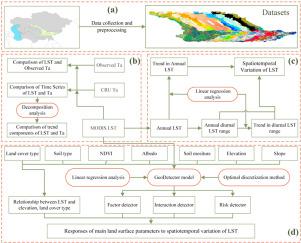当前位置:
X-MOL 学术
›
J. Arid Environ.
›
论文详情
Our official English website, www.x-mol.net, welcomes your feedback! (Note: you will need to create a separate account there.)
Quantifying the influences of land surface parameters on LST variations based on GeoDetector model in Syr Darya Basin, Central Asia
Journal of Arid Environments ( IF 2.7 ) Pub Date : 2021-03-01 , DOI: 10.1016/j.jaridenv.2020.104415 Wei Wang , Alim Samat , Jilili Abuduwaili , Yongxiao Ge
Journal of Arid Environments ( IF 2.7 ) Pub Date : 2021-03-01 , DOI: 10.1016/j.jaridenv.2020.104415 Wei Wang , Alim Samat , Jilili Abuduwaili , Yongxiao Ge

|
Abstract Spatiotemporal variability in the land surface energy flux is largely and comprehensively affected by many factors, including land surface temperature (LST), land coverage, soil characteristics, terrain conditions, etc. In contrast with other climatic zones, arid and semiarid lands have fragile ecological environments that are more sensitive to land surface energy flux changes. In this study, we used MODerate Resolution Imaging Spectroradiometer (MODIS) LST products (2001–2015) for air temperature comparisons. Then, we investigated the spatiotemporal variation in LSTs in the Syr Darya Basin (SDB) during 2001–2015. More specifically, a new statistical model known as GeoDetector was adopted to analyze the driving factors controlling the spatiotemporal variation in LSTs. The result shows that the MODIS LST can provide a good estimation of air temperature, especially at night. The LST change rate can be considered as an important indicator of climate change (rapid warming at high altitudes) and human activities (increased water consumption of crop). Based on the GeoDetector model, we determined that the elevation explained more of the LST distribution (84–90%) and spatiotemporal variation (22–26%) than any other land surface parameters. The combination of albedo and the other explanatory variables can significantly increase the explanatory power of each single factor, especially with elevation.
中文翻译:

基于GeoDetector模型的中亚锡尔河盆地陆面参数对LST变化影响的量化
摘要 地表能量通量的时空变异性受地表温度(LST)、土地覆盖、土壤特征、地形条件等多种因素的综合影响。对地表能量通量变化更为敏感的生态环境。在本研究中,我们使用中分辨率成像光谱仪 (MODIS) LST 产品 (2001–2015) 进行气温比较。然后,我们调查了 2001-2015 年锡尔河盆地 (SDB) 中 LST 的时空变化。更具体地说,采用一种称为 GeoDetector 的新统计模型来分析控制 LST 时空变化的驱动因素。结果表明,MODIS LST 可以很好地估计气温,尤其是在夜间。LST 变化率可以被认为是气候变化(高海拔地区快速变暖)和人类活动(作物耗水量增加)的重要指标。基于 GeoDetector 模型,我们确定高程比任何其他地表参数更能解释 LST 分布(84-90%)和时空变化(22-26%)。反照率和其他解释变量的结合可以显着提高每个单一因素的解释力,尤其是在海拔高度的情况下。基于 GeoDetector 模型,我们确定高程比任何其他地表参数更能解释 LST 分布(84-90%)和时空变化(22-26%)。反照率和其他解释变量的结合可以显着提高每个单一因素的解释力,尤其是在海拔高度的情况下。基于 GeoDetector 模型,我们确定高程比任何其他地表参数更能解释 LST 分布(84-90%)和时空变化(22-26%)。反照率和其他解释变量的结合可以显着提高每个单一因素的解释力,尤其是在海拔高度的情况下。
更新日期:2021-03-01
中文翻译:

基于GeoDetector模型的中亚锡尔河盆地陆面参数对LST变化影响的量化
摘要 地表能量通量的时空变异性受地表温度(LST)、土地覆盖、土壤特征、地形条件等多种因素的综合影响。对地表能量通量变化更为敏感的生态环境。在本研究中,我们使用中分辨率成像光谱仪 (MODIS) LST 产品 (2001–2015) 进行气温比较。然后,我们调查了 2001-2015 年锡尔河盆地 (SDB) 中 LST 的时空变化。更具体地说,采用一种称为 GeoDetector 的新统计模型来分析控制 LST 时空变化的驱动因素。结果表明,MODIS LST 可以很好地估计气温,尤其是在夜间。LST 变化率可以被认为是气候变化(高海拔地区快速变暖)和人类活动(作物耗水量增加)的重要指标。基于 GeoDetector 模型,我们确定高程比任何其他地表参数更能解释 LST 分布(84-90%)和时空变化(22-26%)。反照率和其他解释变量的结合可以显着提高每个单一因素的解释力,尤其是在海拔高度的情况下。基于 GeoDetector 模型,我们确定高程比任何其他地表参数更能解释 LST 分布(84-90%)和时空变化(22-26%)。反照率和其他解释变量的结合可以显着提高每个单一因素的解释力,尤其是在海拔高度的情况下。基于 GeoDetector 模型,我们确定高程比任何其他地表参数更能解释 LST 分布(84-90%)和时空变化(22-26%)。反照率和其他解释变量的结合可以显着提高每个单一因素的解释力,尤其是在海拔高度的情况下。


























 京公网安备 11010802027423号
京公网安备 11010802027423号